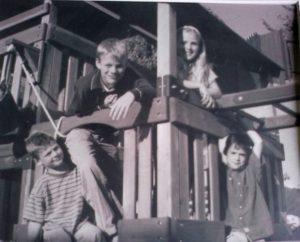 I recently notched up ten years of working at Tyro Payments, a tiny little payments startup that I joined in late 2006 when it had about 20 people, and which is now Australia’s most successful fintech venture, Australia’s newest bank, and is fast approaching 400 staff.
I recently notched up ten years of working at Tyro Payments, a tiny little payments startup that I joined in late 2006 when it had about 20 people, and which is now Australia’s most successful fintech venture, Australia’s newest bank, and is fast approaching 400 staff.
Here’s a collection of some of my most vivid recollections from so far in this fantastic journey.
Getting Hired
I remember… when the recruiter for Tyro said he had a finance role, and I reiterated to him that I wasn’t going to take any job in finance. He back-pedalled, convinced me it wasn’t really a finance company and I really had to go meet them. I was reluctant, but I went along because I wanted to be in his good books.
I remember… the hook for me was one of the founders – Peter Haig – drawing the architecture they were building and me thinking 1) this is very cool and 2) this guy is very smart.
I remember… I plucked up the courage to ask where the company got its money from after three years of runway with no customers, and the founder was completely unfazed that a software engineer would ask such a question.
I remember… asking whether they really wrote tests before making any changes to the system, even to web pages, and Matt Milliss saying, “To be honest, I can’t believe how much code I wrote without tests before I came here, and how many bugs I must have created that no one has found yet.” It was a statement that shook my confidence in myself as an engineer and made me want to learn from this mature group of people that seemed to have a bunch of things figured out that most other software teams were still battling with.
I remember… I was so concerned about whether or not I’d enjoy pair programming that I asked for extra time to think about the offer.
I remember… discussing with my wife what would happen if I joined a startup and it went under and how long we thought we could survive on her salary if it took a while for me to find another job.
Startup Land
 I remember… on my first day I spent the morning pairing with Mark, who patiently spent the whole time telling me about the architecture of the system. We swapped pairs at lunchtime and I stayed on the task. My new pair, Geoff, asked me what we’d done in the morning and I said, “Nothing, we just talked about the system.” He looked at me strange, shook his head, and said “Right”. Then he changed a test, I changed the implementation to make it pass, and within half an hour we’d checked my first change into the mainline.
I remember… on my first day I spent the morning pairing with Mark, who patiently spent the whole time telling me about the architecture of the system. We swapped pairs at lunchtime and I stayed on the task. My new pair, Geoff, asked me what we’d done in the morning and I said, “Nothing, we just talked about the system.” He looked at me strange, shook his head, and said “Right”. Then he changed a test, I changed the implementation to make it pass, and within half an hour we’d checked my first change into the mainline.
I remember… for the first six months having to explain to people that I worked at a company called MoneySwitch, watching their confused and concerned face, and preparing to explain that it wasn’t a money-laundering operation.
I remember… in the first office I worked in, we had no dishwasher and everyone was on a washing up roster, including the CEO.
I remember… that first office got really hot and the building aircon sucked. We had a single portable air conditioner… which was dedicated to the server room. On hot days we’d open a few windows and try to create a cross-breeze with a fan or two, but mostly we’d just sweat it out and keep going, or take a break for slurpees.
I remember… the whole Dev team – all 12 of us – used to go out to the mall to eat lunch together almost every day. There was no room to eat lunch in the office.
I remember… that the fortnightly demo involved the whole company – all 20 of us – cramming into the 3m x 10m board room and sharing a single case of beer.
I remember… when we moved to occupy two levels of 125 York St (now home to Blue Chilli) and it felt like we’d been upgraded to The Ritz.
I remember… when, less than 6 months in, my team leader proactively had my salary adjusted up because she thought Tyro had unwittingly hired me cheap based on my experience. It was an eye-opening example of how serious Tyro was about living out the company’s values.
Engineering Feats and Follies
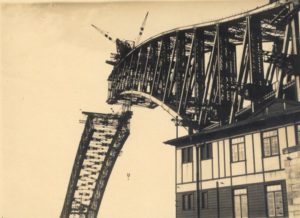 I remember… when Ricky Yim and I got to do a spike of making a POS and an EFTPOS terminal integrate by communicating over the internet and through our system instead of over a serial cable and we got it working in a couple of days – probably Australia’s first “cloud” POS integration.
I remember… when Ricky Yim and I got to do a spike of making a POS and an EFTPOS terminal integrate by communicating over the internet and through our system instead of over a serial cable and we got it working in a couple of days – probably Australia’s first “cloud” POS integration.
I remember… we discovered two years later that a demultiplexer in our POS integration was using a single thread to process all requests from thousands of clients and had only just started to struggle with that load. We bought ourselves about another decade of scaling by changing a config file.
I remember… I “refactored” an API between two systems that had some poorly-named fields, and a week later we mysteriously stopped paying merchants for the cashout they’d given customers. And we only knew about it when they called to complain. No one ever asked who’d made this bug happen, and instead the team had a conversation about how to stop it from happening again.
I remember… us being (equal) first to be accepted to be an acquirer for Medicare EasyClaim online claiming, and the excitement and enthusiasm of being part of building this huge new thing that was going to help improve the country’s public health system. Today, Tyro processes more than half of all the claims on the EasyClaim system, despite four other major banks offering EasyClaim services.
I remember… a litany of small tools that I built at home and brought to work: Canopy, the Maven multi-project build UI; Mini-Rest, a tiny Servlet library that forced people to use proper REST semantics; SodaTest, a Scala-based integration testing framework intended as a replacement for FIT; “Who’s the Expert?”, a smart contributor scoreboard for Bitbucket Server; and probably heaps of others I’ve forgotten.
I remember… relishing the opportunity to be part of rebuilding the accounting system from scratch to fix its performance and maintainability issues. It’s still humming along half a decade later!
I remember… half-jokingly whinging to my boss about how it was coming up to 12 months since I’d been working on nothing but the accounting system, and I might have to find another job if I was going to be doing nothing but accounting for the rest of my life. He moved me off that piece of work a week before 12 months.
Levelling Up
 I remember… when I and three others were pulled aside to a corner of the office (we didn’t have any meeting rooms) to meet Mike Cannon-Brookes. He was considering joining our board but he wanted to meet (and grill!) some of the senior Engineering staff first so that he could check whether we were as good as our management team said we were. He joined, so I guess we did okay.
I remember… when I and three others were pulled aside to a corner of the office (we didn’t have any meeting rooms) to meet Mike Cannon-Brookes. He was considering joining our board but he wanted to meet (and grill!) some of the senior Engineering staff first so that he could check whether we were as good as our management team said we were. He joined, so I guess we did okay.
I remember… asking if I could take on a few more responsibilities because I was bored and, instead of being given an extra job or two, I was told I’d be made an Engineering Lead.
I remember… first getting involved in interviewing, not having any idea what I was doing, and feeling the weight of making decisions that would significantly affect other people’s lives and the future of the company.
I remember… we used to ask people to write a function on a whiteboard to calculate factorials and it took us way too long to realise it wasn’t testing people’s coding skills at all and that just getting people to do some pairing was way better.
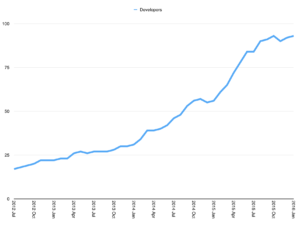 I remember… we hired so many people that we doubled the size of the team in 18 months. And then we did it again. And then we did it again.
I remember… we hired so many people that we doubled the size of the team in 18 months. And then we did it again. And then we did it again.
I remember… that I was just coping to remember all the new people’s names, then I went on holiday for a week, missed four new starters, and never recovered.
I remember… when the Engineering team eventually grew so big that we reluctantly moved Ops to a different floor of the building, and communication between the two groups plummeted.
I remember… pairing with Ops on mystery catastrophe nights, all scratching our heads, ordering pizza when we realised it was way past dinner time, and that “Aha!” feeling when someone found an entry in a log or ran a query on a table that had seemed totally unrelated to the symptoms but showed something that no one expected could ever happen.
I remember… organising our first innovation sprint – ‘CodeBlitz’ – and being surprised by the different mood in the room as people were intensely focused on getting their own innovative idea hacked together within two days so they could demo it.
I remember… when we decided it would be a good idea to build our next link to another bank as its own piece of software rather than adding it to an existing monolith – one of our first steps toward a microservices architecture (before that word existed). We recently celebrated having over 100 services deployed in Production.
The Journey to the Bank
 I remember… that time my boss came to me and asked if my team could start on building a bank the next week.
I remember… that time my boss came to me and asked if my team could start on building a bank the next week.
I remember… when we took a completely agile approach to building a bank…
“Where do we start?”
“Well, what’s the most important thing a bank does?”
“Keeps people’s money in an account.”
“Okay, let’s write a piece of software that keeps money in an account instead of sending it to another bank.”
And so we wrote that and got it working before we did anything else.
I remember… when the regulator announced they were retiring our limited EFTPOS banking license, and we were told the banking side-project was now the rush to a full banking license mission, the #1 priority of the company, and that we had 18 months to deliver.
I remember… when we were 12 months into building our core banking system, just weeks away from delivering it exactly when we had estimated… and someone uncovered 3 more months of mandatory work.
I remember… when we received the results of an external security audit of our in-progress core banking system and the synopsis was “You guys are pretty up there with your security, but here’s 15 other major things you should think about improving.”
I remember… the frankly unbelievable news that we’d been granted a full banking license by APRA. It felt like a war was over.
I remember… when we’d just finished turning on the core banking system and we were told, “Well done. Now you’ve got 12 months to build a lending product from scratch, ship it, and get customers onto it.” We did it in 6.
Time Keeps on Slipping
 I remember… feeling like my contribution to the company was having less and less impact due to the growth and organisational changes, and starting to seriously think about moving on to somewhere else. Eventually, I realised that I didn’t have to be bound by my historical contribution to Engineering, and that Product Management might be a place where I could probably develop a new expertise and have a large impact on the company’s future.
I remember… feeling like my contribution to the company was having less and less impact due to the growth and organisational changes, and starting to seriously think about moving on to somewhere else. Eventually, I realised that I didn’t have to be bound by my historical contribution to Engineering, and that Product Management might be a place where I could probably develop a new expertise and have a large impact on the company’s future.
I remember… getting up the courage to ask the co-founder and Head of Product about moving into a Product Management role, expecting to get a grilling about what product was and what skills I had that I thought would be relevant. Instead his response was just, “Yeah, that makes sense. When would you like to move?”
I asked my wife what she remembers, and she said she remembers when she would show up to the Christmas party and know everyone’s name, but nowadays I sometimes tell her I’m going to someone’s leaving drinks and she says she’s never heard of them.
I remember… starting to reflect on what I’d been part of in 10 years at Tyro and realising there was almost nothing that I’d achieved by myself; everything significant I’d been involved in had been a team effort – sometimes a team of two, sometimes over a hundred, but almost always a team. That’s how we roll.
Image credits:
‘Kids, older photo‘ by Joe Crawford
‘Start of the Steep Trail‘ by Dan Cook
‘Sydney Harbour Bridge‘ by gramarye
‘Power ups‘ by Kirt Edblom
‘Bankers‘ by Chris Brown
‘Eye of the Beholder‘ by hjl (flickr)




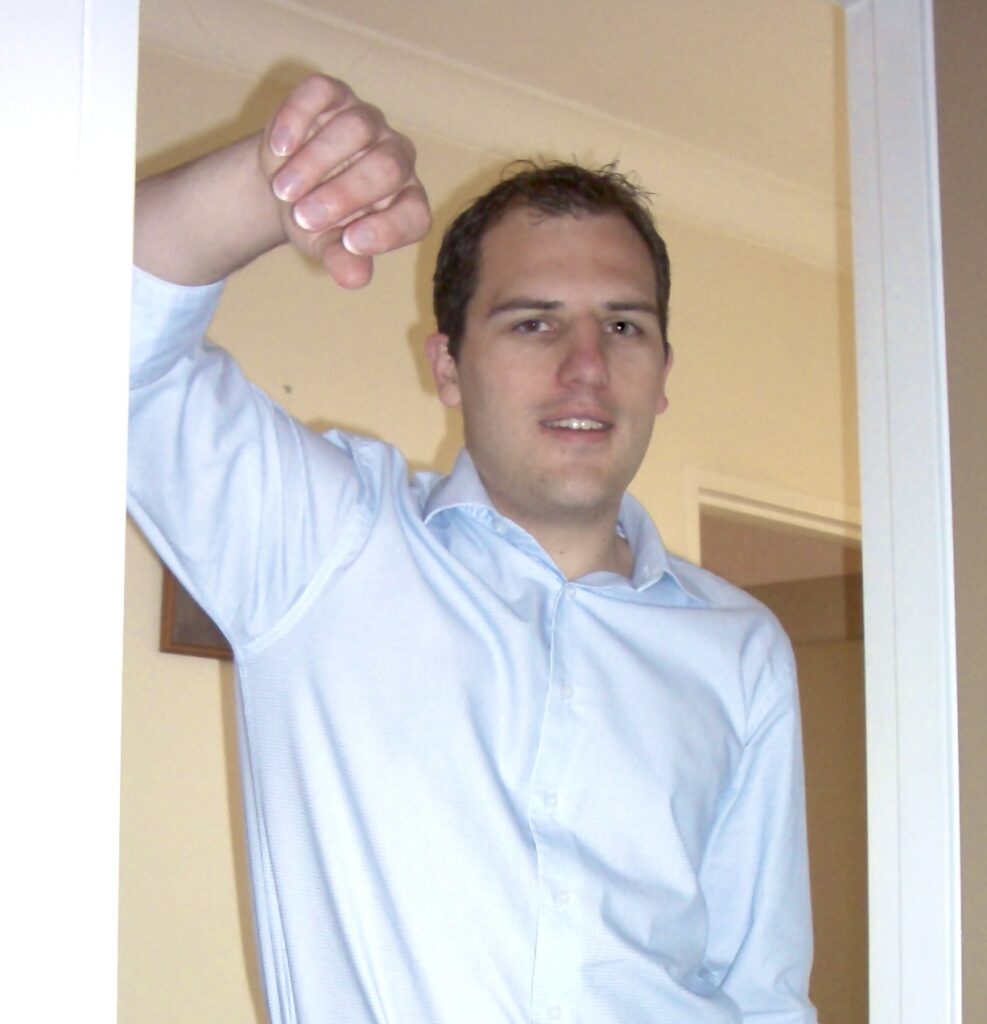


 I recently notched up ten years of working at Tyro Payments, a tiny little payments startup that I joined in late 2006 when it had about 20 people, and which is now Australia’s most successful fintech venture, Australia’s newest bank, and is fast approaching 400 staff.
I recently notched up ten years of working at Tyro Payments, a tiny little payments startup that I joined in late 2006 when it had about 20 people, and which is now Australia’s most successful fintech venture, Australia’s newest bank, and is fast approaching 400 staff. I remember… on my first day I spent the morning pairing with Mark, who patiently spent the whole time telling me about the architecture of the system. We swapped pairs at lunchtime and I stayed on the task. My new pair, Geoff, asked me what we’d done in the morning and I said, “Nothing, we just talked about the system.” He looked at me strange, shook his head, and said “Right”. Then he changed a test, I changed the implementation to make it pass, and within half an hour we’d checked my first change into the mainline.
I remember… on my first day I spent the morning pairing with Mark, who patiently spent the whole time telling me about the architecture of the system. We swapped pairs at lunchtime and I stayed on the task. My new pair, Geoff, asked me what we’d done in the morning and I said, “Nothing, we just talked about the system.” He looked at me strange, shook his head, and said “Right”. Then he changed a test, I changed the implementation to make it pass, and within half an hour we’d checked my first change into the mainline. I remember… when
I remember… when  I remember… when I and three others were pulled aside to a corner of the office (we didn’t have any meeting rooms) to meet Mike Cannon-Brookes. He was considering joining our board but he wanted to meet (and grill!) some of the senior Engineering staff first so that he could check whether we were as good as our management team said we were. He joined, so I guess we did okay.
I remember… when I and three others were pulled aside to a corner of the office (we didn’t have any meeting rooms) to meet Mike Cannon-Brookes. He was considering joining our board but he wanted to meet (and grill!) some of the senior Engineering staff first so that he could check whether we were as good as our management team said we were. He joined, so I guess we did okay. I remember… we hired so many people that we doubled the size of the team in 18 months. And then we did it again. And then we did it again.
I remember… we hired so many people that we doubled the size of the team in 18 months. And then we did it again. And then we did it again. I remember… that time my boss came to me and asked if my team could start on building a bank the next week.
I remember… that time my boss came to me and asked if my team could start on building a bank the next week. I remember… feeling like my contribution to the company was having less and less impact due to the growth and organisational changes, and starting to seriously think about moving on to somewhere else. Eventually, I realised that I didn’t have to be bound by my historical contribution to Engineering, and that Product Management might be a place where I could probably develop a new expertise and have a large impact on the company’s future.
I remember… feeling like my contribution to the company was having less and less impact due to the growth and organisational changes, and starting to seriously think about moving on to somewhere else. Eventually, I realised that I didn’t have to be bound by my historical contribution to Engineering, and that Product Management might be a place where I could probably develop a new expertise and have a large impact on the company’s future. Why are distributed transactions icebergs? It’s not because they’re cool and beautiful and you have to look under the surface to comprehend them.
Why are distributed transactions icebergs? It’s not because they’re cool and beautiful and you have to look under the surface to comprehend them. I’ve seen a lot of software engineers’ resumes over the past few years. And most of them suck. Even the resumes of really good people who we’ve hired have often been very average.
I’ve seen a lot of software engineers’ resumes over the past few years. And most of them suck. Even the resumes of really good people who we’ve hired have often been very average.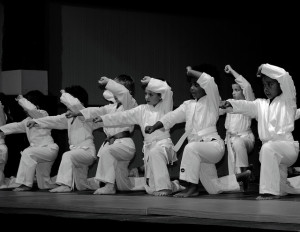 At Tyro,
At Tyro,